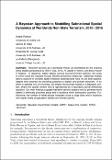Files in this item
A Bayesian approach to modelling subnational spatial dynamics of worldwide non-state terrorism, 2010-2016
Item metadata
| dc.contributor.author | Python, Andre | |
| dc.contributor.author | Illian, Janine B. | |
| dc.contributor.author | Jones-Todd, Charlotte M. | |
| dc.contributor.author | Blangiardo, Marta | |
| dc.date.accessioned | 2019-05-27T23:38:06Z | |
| dc.date.available | 2019-05-27T23:38:06Z | |
| dc.date.issued | 2018-05-28 | |
| dc.identifier | 252871422 | |
| dc.identifier | 7eb35b97-c55a-4fc6-8b00-229b5bd82e90 | |
| dc.identifier | 85047666558 | |
| dc.identifier | 000453560000013 | |
| dc.identifier.citation | Python , A , Illian , J B , Jones-Todd , C M & Blangiardo , M 2018 , ' A Bayesian approach to modelling subnational spatial dynamics of worldwide non-state terrorism, 2010-2016 ' , Journal of the Royal Statistical Society: Series A (Statistics in Society) , vol. Early View . https://doi.org/10.1111/rssa.12384 | en |
| dc.identifier.issn | 0964-1998 | |
| dc.identifier.other | ORCID: /0000-0001-8094-7226/work/45366217 | |
| dc.identifier.uri | https://hdl.handle.net/10023/17769 | |
| dc.description.abstract | Terrorism persists as a worldwide threat, as exemplified by the on‐going lethal attacks perpetrated by Islamic State in Iraq and Syria, Al Qaeda in Yemen and Boko Haram in Nigeria. In response, states deploy various counterterrorism policies, the costs of which could be reduced through efficient preventive measures. Statistical models that can account for complex spatiotemporal dependences have not yet been applied, despite their potential for providing guidance to explain and prevent terrorism. To address this shortcoming, we employ hierarchical models in a Bayesian context, where the spatial random field is represented by a stochastic partial differential equation. Our main findings suggest that lethal terrorist attacks tend to generate more deaths in ethnically polarized areas and in locations within democratic countries. Furthermore, the number of lethal attacks increases close to large cities and in locations with higher levels of population density and human activity. | |
| dc.format.extent | 17165278 | |
| dc.language.iso | eng | |
| dc.relation.ispartof | Journal of the Royal Statistical Society: Series A (Statistics in Society) | en |
| dc.subject | Bayesian hierarchical models | en |
| dc.subject | GMRF | en |
| dc.subject | Space-time models | en |
| dc.subject | SPDE | en |
| dc.subject | Terrorism | en |
| dc.subject | HA Statistics | en |
| dc.subject | QA Mathematics | en |
| dc.subject | JZ International relations | en |
| dc.subject | DAS | en |
| dc.subject | SDG 16 - Peace, Justice and Strong Institutions | en |
| dc.subject.lcc | HA | en |
| dc.subject.lcc | QA | en |
| dc.subject.lcc | JZ | en |
| dc.title | A Bayesian approach to modelling subnational spatial dynamics of worldwide non-state terrorism, 2010-2016 | en |
| dc.type | Journal article | en |
| dc.contributor.institution | University of St Andrews. School of Mathematics and Statistics | en |
| dc.contributor.institution | University of St Andrews. Scottish Oceans Institute | en |
| dc.contributor.institution | University of St Andrews. Centre for Research into Ecological & Environmental Modelling | en |
| dc.identifier.doi | https://doi.org/10.1111/rssa.12384 | |
| dc.description.status | Peer reviewed | en |
| dc.date.embargoedUntil | 2019-05-28 |
This item appears in the following Collection(s)
Items in the St Andrews Research Repository are protected by copyright, with all rights reserved, unless otherwise indicated.

